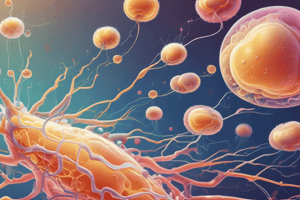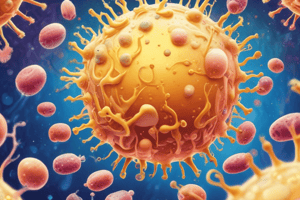Podcast
Questions and Answers
What is the primary function of the catalase enzyme produced by staphylococci?
What is the primary function of the catalase enzyme produced by staphylococci?
- To inhibit phagocytosis by polymorphonuclear leukocytes
- To produce toxins that disrupt biologic membranes
- To convert hydrogen peroxide into water and oxygen (correct)
- To break down fibrinogen
What is the main difference between coagulase and clumping factor in S.aureus?
What is the main difference between coagulase and clumping factor in S.aureus?
- Coagulase is an enzyme-like protein, while clumping factor is a protein
- Coagulase is involved in adherence to fibrinogen, while clumping factor clots plasma (correct)
- Coagulase is bound to the cell wall, while clumping factor is extracellular
- Coagulase is responsible for fibrin polymerization, while clumping factor is responsible for fibrinolysis
Which of the following enzymes is responsible for fibrinolysis in S.aureus?
Which of the following enzymes is responsible for fibrinolysis in S.aureus?
- Staphylokinase (correct)
- Hyaluronidase
- Lipases
- Streptokinase
What is the primary function of teichoic acids in S.aureus?
What is the primary function of teichoic acids in S.aureus?
Which of the following hemolysins is responsible for lysing white blood cells?
Which of the following hemolysins is responsible for lysing white blood cells?
What is the characteristic of exfoliative toxin A?
What is the characteristic of exfoliative toxin A?
Which of the following enzymes is responsible for breaking down lipids in S.aureus?
Which of the following enzymes is responsible for breaking down lipids in S.aureus?
What is the primary function of the polysaccharide capsules in S.aureus?
What is the primary function of the polysaccharide capsules in S.aureus?
What is the characteristic of coagulase in S.aureus?
What is the characteristic of coagulase in S.aureus?
Which of the following enzymes is responsible for breaking down proteins in S.aureus?
Which of the following enzymes is responsible for breaking down proteins in S.aureus?
Flashcards are hidden until you start studying
Study Notes
Staphylococcal Infections
- Staphylococci may be refractory to treatment due to biofilm formation.
- S. lugdunensis is a virulent organism causing a disease spectrum similar to S. aureus, with phenotypic characteristics like hemolysis and clumping factor.
- S. saprophyticus is typically nonpigmented, novobiocin-resistant, and nonhemolytic, causing urinary tract infections in young women.
Clinical Findings
- Localized staphylococcal infections appear as pimples, hair follicle infections, or abscesses with intense, localized, painful inflammatory reactions that undergo central suppuration and heal quickly when pus is drained.
- S. aureus infection can result from direct contamination of wounds, such as postoperative staphylococcal wound infections or infections after trauma (chronic osteomyelitis subsequent to an open fracture, meningitis after skull fracture).
- Disseminated S. aureus infection can lead to endocarditis, acute hematogenous osteomyelitis, meningitis, or pulmonary infection.
- Food poisoning caused by staphylococcal enterotoxin is characterized by a short incubation period (1-8 hours), violent nausea, vomiting, diarrhea, and rapid convalescence without fever.
- Toxic shock syndrome is manifested by an abrupt onset of high fever, vomiting, diarrhea, myalgias, a scarlatiniform rash, and hypotension with cardiac and renal failure in severe cases.
Diagnostic Laboratory Tests
- Specimens for testing include surface swabs, pus or aspirate from an abscess, blood, endonasotracheal aspirate, expectorated sputum, or spinal fluid.
- Gram-stained smears of pus or sputum show typical staphylococci as Gram-positive cocci in clusters.
- Specimens planted on blood agar plates give rise to typical colonies in 18 hours at 37°C, but hemolysis and pigment production may not occur until several days later and are optimal at room temperature.
- S. aureus ferments mannitol, but other staphylococci do not.
Catalase Test and Coagulase Test
- The catalase test involves placing a drop of 3% hydrogen peroxide solution on a slide with bacterial growth; the formation of bubbles indicates a positive test result.
- The coagulase test involves mixing citrated rabbit or human plasma with an equal volume of broth culture or growth from colonies on agar, and incubating at 37°C; clot formation in 1-4 hours indicates a positive test result.
Antimicrobial Susceptibility Testing
- Broth microdilution or disk diffusion susceptibility testing should be done routinely on staphylococcal isolates from clinically significant infections.
- Resistance to penicillin G can be predicted by a positive test result for β-lactamase; approximately 90% of S. aureus produce β-lactamase.
- Resistance to nafcillin (and oxacillin and methicillin) occurs in about 65% of S. aureus and approximately 75% of S. epidermidis isolates.
Prevention
- Preventive measures aim to control reinfection and eliminate the carrier state in patients subject to recurrent infection, such as chronic furunculosis.
- Clothes and bedding that may cause reinfection should be dry-cleaned or washed at a high temperature (70°C or higher) to destroy staphylococci.
Enzymes and Toxins
- Staphylococci produce catalase, which converts hydrogen peroxide into water and oxygen.
- Coagulase binds to prothrombin, initiating fibrin polymerization, and may deposit fibrin on the surface of staphylococci, altering their ingestion by phagocytic cells.
- Clumping factor is cell wall bound and responsible for adherence to fibrinogen and fibrin.
- Other enzymes produced by staphylococci include hyaluronidase, staphylokinase, proteinases, lipases, and β-lactamase.
- Hemolysins include α-hemolysin, β-toxin, δ-toxin, and γ-hemolysin, which act on eukaryotic cell membranes, human red blood cells, and white blood cells.
- Exfoliative toxins A and B are heat-stable and heat-labile, respectively, and disrupt biologic membranes.
Studying That Suits You
Use AI to generate personalized quizzes and flashcards to suit your learning preferences.





